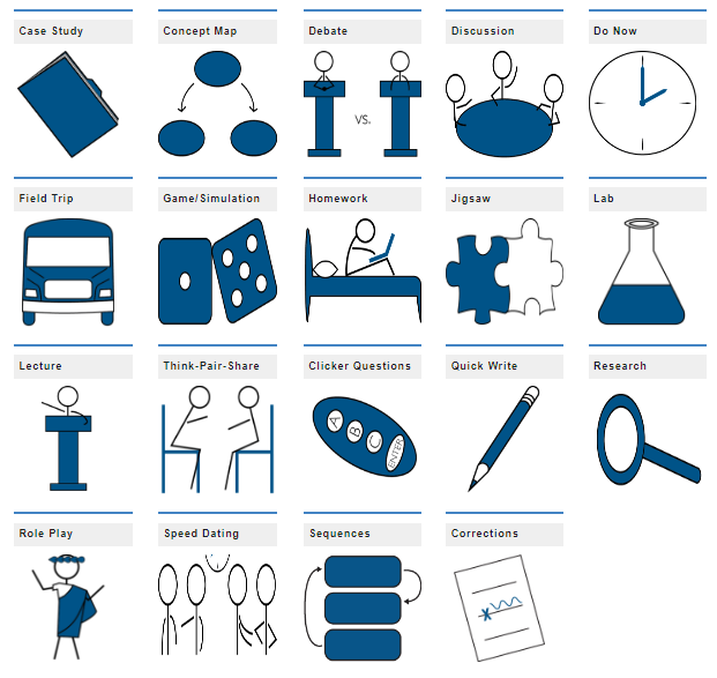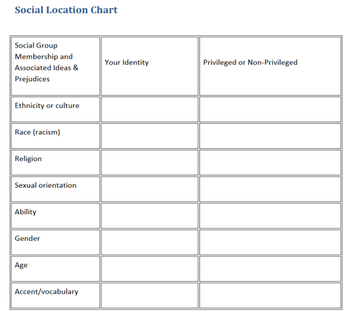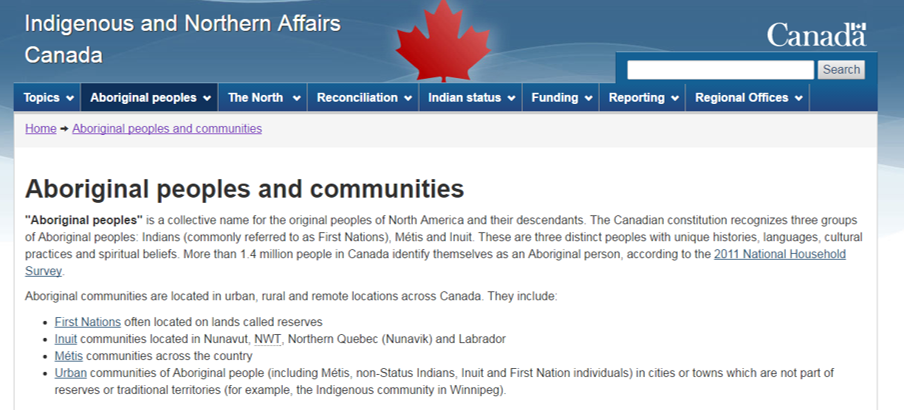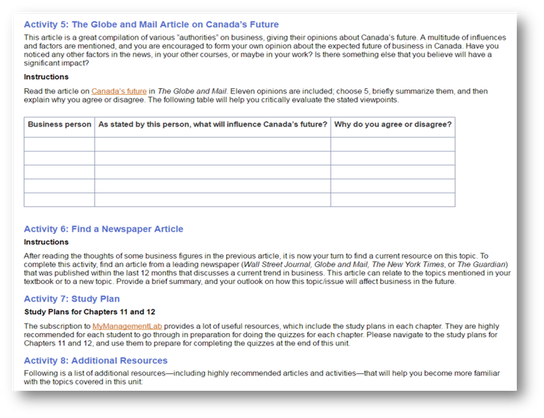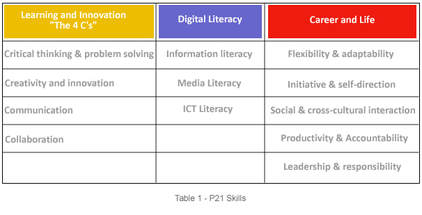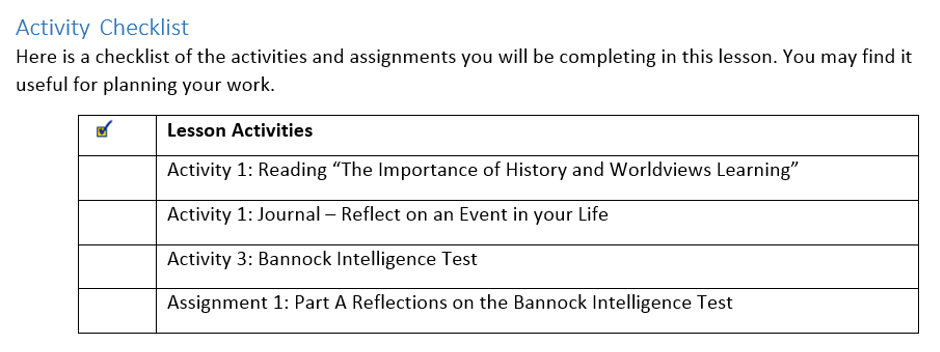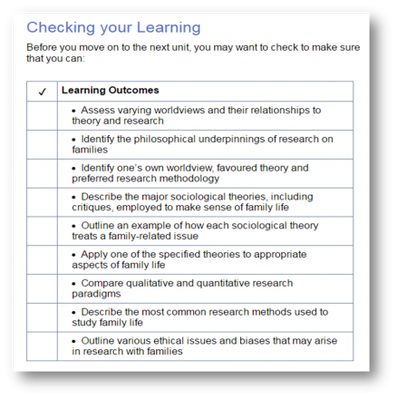Learning Activities
As the image below suggests, instructors show learners where they are in terms of their grasp of the course material. Learning activities help students understand the course content and prepare them for the assessments. They also help the instructor know if the students understand the concepts in the lesson.
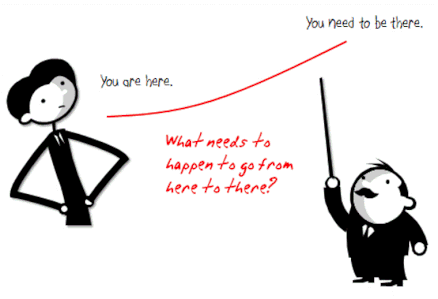
Here are some possible learning activities to include in a lesson:
- Reading (textbook, article, webpage)
- Discussions / Debates (class, group, pair)
- Case studies
- Experiments
- Video / Podcast
- Interview (in/out of class)
- Field Trip / Simulations / Role play
- Games
- Quizzes
Learning Activity Ideas
Liberating Structures
These activities provide a different way to organize group work, meetings, presentations, discussions, reports, and brainstorming sessions. Liberating Structures have been very successful in face-to-face environments, and some are also being modified and used in online courses. Here are a couple that can work well in class and online:
These activities provide a different way to organize group work, meetings, presentations, discussions, reports, and brainstorming sessions. Liberating Structures have been very successful in face-to-face environments, and some are also being modified and used in online courses. Here are a couple that can work well in class and online:
- 1-2-4-all: Pose a question and participants will answer, first alone, then in pairs, then foursomes, and finally as a whole group.
- What, So What, Now What? W³: After a shared experience, ask, “WHAT? What happened? What did you notice, what facts or observations stood out?” Then, after all the salient observations have been collected, ask, “SO WHAT? Why is that important? What patterns or conclusions are emerging? What hypotheses can you make?” Then, after the sense making is over, ask, “NOW WHAT? What actions make sense?”
- Troika Consulting: In quick round-robin “consultations,” individuals ask for help and get advice immediately from two others. Peer-to-peer coaching helps with discovering everyday solutions, revealing patterns, and refining prototypes.
- 9 Whys: Ask, “What do you do when working on ______ (the subject matter or challenge at hand)? Please make a short list of activities.” Then ask, “Why is that important to you?” Keep asking, “Why? Why? Why?” up to nine times or until participants can go no deeper because they have reached the fundamental purpose for this work.
Check out the following links for more information:
- Liberating Structures Website: Provides a menu of activity ideas (see image above)
- Active Learning with Liberating Structures from Royal Roads University. There are several ideas for online activities as well.
- The 12 Apps of Christmas: Liberating Structures. This highlights activities that can be used with the Liberating Structures app.
Activity Types
Another great website to check out is Activity Types from Harvard University. See the image below for the activity ideas.
Another great website to check out is Activity Types from Harvard University. See the image below for the activity ideas.
More Learning Activity Ideas
Check out these websites and ideas for more activity options for your face-to-face or online class:
Check out these websites and ideas for more activity options for your face-to-face or online class:
- Classroom Assessment Techniques: Quick Strategies to Check Student Learning in Class
- 1 Minute Paper, Muddiest Point, Student-Generated Questions, Peer Review
- Examples of Active Learning Activities from Queen's University. Great ideas for large groups, small groups, and individuals.
- Think-Share-Pair, Fishbowl, Buzz Groups, Dotmocracy, Snowball, Line-up, Post-It Parade, Case Studies, Pro-Cons Grid
- Practical Strategies for the Classroom from Pedagogy Unbound
- Quickwrite, Monte Carlo Quiz, Jeopardy
- Online Teaching Activity Index from Illinois Online Index
- Jigsaw, KWL, Concept Mapping, Gaming, Role Playing, Journaling, Blogging, Wikis, Scavenger Hunt.
- Teaching Tips from University of Waterloo
- Brainstorming, Quescussion, Debate, 1 Sentence Summary, Twitter Scavenger Hunt, The Alphabet Game, Find Post & Vote
- Active Learning For The College Classroom
- The Pre-Theoretic Intuitions Quiz, Active Review Sessions, Visual Lists, Panel Discussions
Icebreakers
Icebreakers are a great way to start the class, as they can build a sense of community and help the student focus on their learning. Here are a couple of great resources and some ideas:
Icebreakers are a great way to start the class, as they can build a sense of community and help the student focus on their learning. Here are a couple of great resources and some ideas:
- 10 Online Icebreakers: Personal Cards, Two Lies and a Truth, Three Words
- The Importance of Icebreakers in Online Classes: Human Scavenger Hunt, Group Resume, Partner Interview
- Adult Virtual Icebreakers: Time Machine, Virtual Nametags, Let's Twitter, Who Done That?
More Technology, Please!
Here are a couple resources for incorporating more Educational Technology in the Classroom
Here are a couple resources for incorporating more Educational Technology in the Classroom
- Choosing Your Technology: Great tech tools from University of Michigan
- Technology solutions: Interesting approaches to common problems of class participation, giving feedback, boring lectures, etc.
- The “All-Time” Best Resources For Educators: A list of resources for videos, visualizations, games, ESL ideas, technology, writing, and much more.
- Catalogue of Open Web resources: Fantastic ideas for using tech - for assignments, course content, activities, etc.
Gamification
A couple more resources for incorporating games in the class:
A couple more resources for incorporating games in the class:
- How Gamification Reshapes Learning: free e-book
- Serious Games Classification: This site is a collaborative classification system suited to Serious Games, based on multiple criterias (gameplay, purposes, markets and target audience).
- Playful Learning: This platform aims to ignite the use of quality games for learning in the classroom.
Top Tips for Online Learning Activities
Below are some basic principles for designing learning activities for your online course.
Provide Guidance
Before the activities, be sure to explain what students will be doing and why it's relevant to the course and to their learning. If they're watching a video, explain the main topic, who the author is, and perhaps how the ideas presented relate to the bigger picture or to a specific case.
Before the activities, be sure to explain what students will be doing and why it's relevant to the course and to their learning. If they're watching a video, explain the main topic, who the author is, and perhaps how the ideas presented relate to the bigger picture or to a specific case.
Check for Student Understanding
Make it personal, current, and relevant
A key idea in developing learning activities are to make them meaningful. Below are some examples that demonstrate how to promote personal awareness (social location chart), keep the course current (Aboriginal news), and relevant (case study).
A key idea in developing learning activities are to make them meaningful. Below are some examples that demonstrate how to promote personal awareness (social location chart), keep the course current (Aboriginal news), and relevant (case study).
Scaffold the Learning
Another key principle in designing courses is to scaffold the lesson. The activities should guide learners through the lesson, giving them opportunities to apply their understanding of the material. See the example below in which students are asked to read an article, then find their own article, and then complete study activities.
Another key principle in designing courses is to scaffold the lesson. The activities should guide learners through the lesson, giving them opportunities to apply their understanding of the material. See the example below in which students are asked to read an article, then find their own article, and then complete study activities.
|
Plan for Skill Development As we consider the types of activities to include in a lesson, it's important to recognize the opportunity we give students to develop certain skills. For example, by asking students to explore certain websites and guiding them with key questions, we may be helping them develop their navigation and analytic skills. The image to the right shows some 21st century skills that we should promote in our courses. Learning activities are just another way we can expose students to these skills. |
Tell 'em!
Lessons should follow the saying: Tell them what you're going to tell them, tell them, and then tell them what you've told them.
At the beginning of each lesson, in addition to listing the learning outcomes, I include an Activity Checklist so students can plan their study time. Then, at the end of the lesson I often have a "Check Your Understanding" feature so the learners can do a self-check of what they've learned.
Once learners confirm they have met the expectations of learning for the lesson, they should then be ready to take the assessment linked to that lesson. All this repetition and reminders help keep learners on track and focused on what they should be learning.
Lessons should follow the saying: Tell them what you're going to tell them, tell them, and then tell them what you've told them.
At the beginning of each lesson, in addition to listing the learning outcomes, I include an Activity Checklist so students can plan their study time. Then, at the end of the lesson I often have a "Check Your Understanding" feature so the learners can do a self-check of what they've learned.
Once learners confirm they have met the expectations of learning for the lesson, they should then be ready to take the assessment linked to that lesson. All this repetition and reminders help keep learners on track and focused on what they should be learning.
